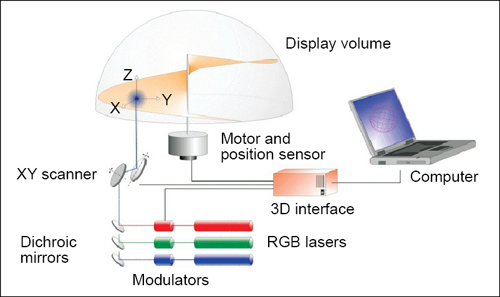Advantages. Less spatial data required, possibility of simultaneous vision by several viewers and less hardware required.
Problems. The viewing side is opposite to that of pick-up side, thus the resultant image is pseudoscopic in nature with reverse depth, that is, we see a convex image for a concave object. So we would need to convert the pseudoscopic image to orthoscopic.


Besides, there is interference between elemental images during pick-up. This interference can be reduced by setting optical barriers between neighbouring lenses.
The NHK Science & Technology Research Laboratories has developed a hexagonal-packed gradient-index (GRIN) fly-eye lens to capture elemental images. In this process, a convex lens is used to control the depth of the reproduced image. The GRIN structure overcomes the pseudoscopic and interference problem. However, the lens structure that they used was bigger, so the reproduced image was somewhat deteriorated. After lot of research the deterioration has been reduced to an acceptable level.
Overall, we can say that, due to small resolution of displays and charged-coupled devices (CCDs), the depth of 3D is insufficient in this integral imaging.
Volumetric displays. This is a completely different approach as here a 3D image is produced in a physical space rather than on a flat screen. The image is said to contain voxels, that is, volumetric pixels that have x, y and depth z coordinated. The voxels appear at different physical depths within the space, thus allowing the eye to converge and focus just as they would converge in the real world. The first volumetric display was created by W.D. Chase in 1976. He used a rotating helix screen.
A volumetric display comprises a rotating helical screen (semi-transparent), computer interface and laser system. The helical screen rotates at such a high speed that it becomes invisible to eyes. The computer provides the required control signals (on/off durations and intensity control) to the 3D interface, which then modulates the RGB lasers to form the required colour combination.
As the light beam hits the rotating screen, it scatters and causes a voxel. The location of this voxel is determined by the intersection of light beam with the rotating helix. Expanding this concept further, instead of using helix structure, an LED array screen is rotated at high speed.
Health-related side effects
Watching excessive 3D content can be very harmful not only for the eyes but also for the brain. The projected 3D content is very much different from the real world that our eyes see. Chromatic adaptation of individuals also plays an important role in the harmful effects of 3D. Some common effects include:
1. Motion sickness
2. Excessive eye strain
3. Disturbance of postural balance that leads to disorientation problems
4. increase in heart beat
5. headache and increased stress levels
The author is a B.Tech fourth-year student at Vidya College of Engineering






